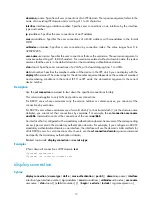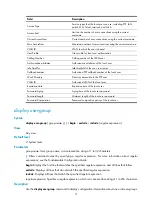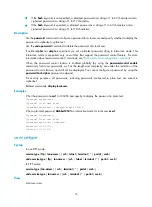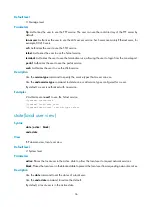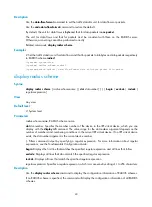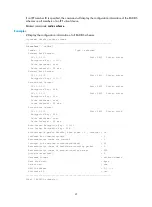
29
Binding attributes are checked upon authentication of a local user. If the binding attributes of a local user
do not match the configured ones, the user will fail the checking and the authentication.
Binding attribute checking does not take the service types of the users into account. A configured binding
attribute is effective for all types of users. Be cautious when deciding which binding attributes should be
configured for which type of local users. For example, an IP address binding is applicable to only 802.1X
authentication that supports IP address upload. If you configure an IP address binding for an
authentication method that does not support IP address upload, for example, MAC authentication, the
local authentication will fail.
Examples
# Configure the bound IP of local user
abc
as 3.3.3.3.
<Sysname> system-view
[Sysname] local-user abc
[Sysname-luser-abc] bind-attribute ip 3.3.3.3
display local-user
Syntax
display local-user
[
idle-cut
{
disable
|
enable
} |
service-type
{
ftp
|
lan-access
|
portal
|
ssh
|
telnet
|
terminal
|
web
} |
state
{
active
|
block
} |
user-name
user-name
|
vlan
vlan-id
] [
slot
slot-number
]
[
|
{
begin
|
exclude
|
include
}
regular-expression
]
View
Any view
Default level
1: Monitor level
Parameters
idle-cut
{
disable
|
enable
}: Specifies local users with the idle cut function disabled or enabled.
service-type
: Specifies the local users that use a specified type of service.
•
ftp
: FTP users.
•
lan-access
: Users accessing the network through Ethernet, such as 802.1X users.
•
portal
: Portal users.
•
ssh
: SSH users.
•
telnet
: Telnet users.
•
terminal
: Users logging in through the console port.
•
web
: Web user.
state
{
active
|
block
}: Specifies local users in the state of active or blocked. A local user in the active
state can access network services, but a local user in the blocked state cannot.
user-name
user-name
: Specifies all local users using the specified username. The username is a
case-sensitive string of 1 to 55 characters and does not contain the domain name.
vlan
vlan-id
: Specifies all local users in a VLAN. The VLAN ID ranges from 1 to 4094.
slot
slot-number
: Specifies the member number of the device in the IRF virtual device, which you can
display with the
display irf
command. The value range for the
slot-number
argument depends on the



